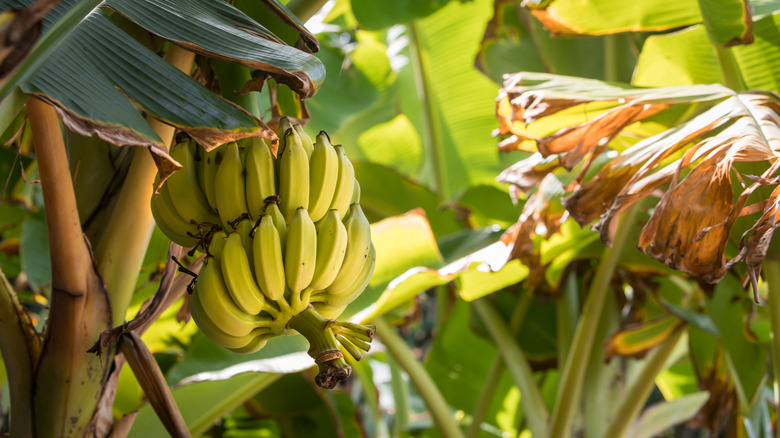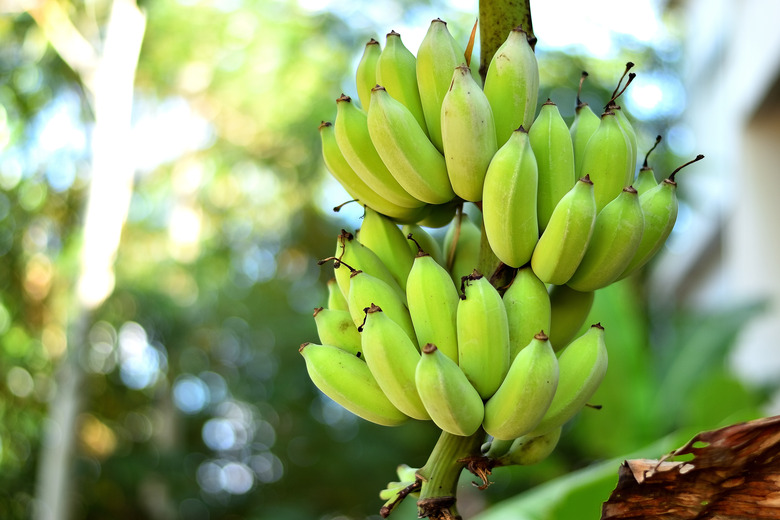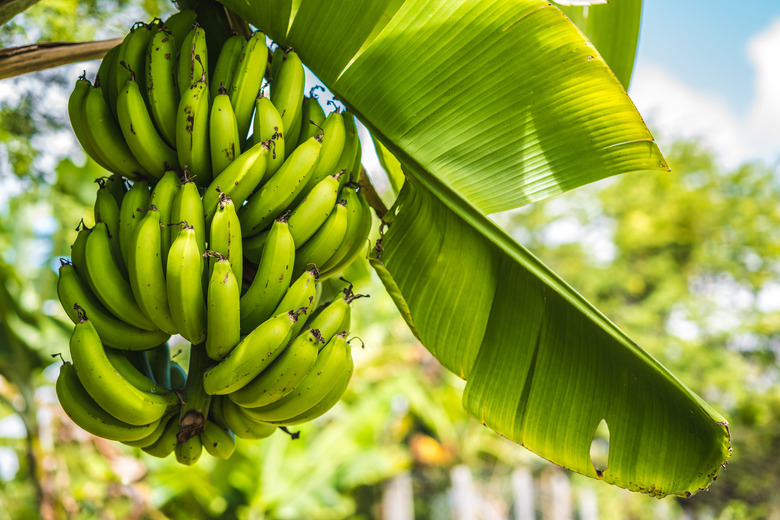How To Grow Bananas
We may receive a commission on purchases made from links.
- Best uses for bananas
- How to grow bananas
- In what zone do bananas grow best?
- When should you plant bananas?
- Soil, sunlight and water recommendations for bananas
- How to propagate bananas
- How to winterize bananas
- How to harvest bananas
- Common pests and other problems for bananas
- Common diseases for bananas
A mature banana (Musa spp.) plant can reach a height of 25 feet, and with its large leaves, which can attain lengths of up to 9 feet, and its fibrous trunk, it looks like a palm tree, but it isn't. In fact, the banana plant isn't a tree at all but a large herbaceous perennial, and it's a lot more fragile than it appears. Huge green banana leaves act like sails in high winds, and the hands of fruit — each individual fruit is a finger — can be heavy enough to bend and even break the trunk. Banana plants protect themselves from strong winds and excessive sunlight by growing together in clumps, so if you want to plant an ornamental variety in your garden, it's probably a good idea to plant more than one.
Like all plants, banana plants originate from seeds, but once established, they self-propagate by sending up suckers from the part of the main trunk that runs horizontally underground (the rhizome), and growers almost always grow new plants from these suckers. Seeded banana varieties grow wild and aren't of much interest to the fruit-loving population because the seeds are large and displace most of the fruit meat.
That's why seedless varieties have been developed, such as the Cavendish bananas you find in the grocery store, but they are endangered. Most come from Central America, where they are threatened by a fungal disease known as banana wilt or Panama disease, which wiped out the previously most-popular Gros Michel variety in the 1950s. By developing an interest in banana cultivation and growing your own, you may become something of a hero to the many people who enjoy this fruit every day in a number of ways.
Best Uses for Bananas
Best Uses for Bananas
When most people think of bananas or plantains, they think of the edible fruit, but there are many types of bananas that you can't eat that are grown as ornamentals. The banana plant grows quickly, usually taking about nine months to flower and produce fingers, although it can take longer in northern climates. The flowers are large and showy, and together with the enormous leaves, they create a visual feast in a sunny and well-protected part of the garden.
People also grow bananas indoors in containers, and while this may seem unusual, it has been common since Victorian times. Dwarf varieties that only attain heights of 4 to 5 feet are most suitable, although if you live in a warm place, it's possible to grow large plants with edible fruit on your patio. Banana varieties best suited for northern climates, however, tend to be ornamentals.
There is more than one reason for planting clumps of bananas rather than a single plant. Banana plants take a safety-in-numbers approach to survival, using each other as windbreaks and providing shade from excessive heat for each other. They also like humidity, which reduces evaporation from their large leaves, and the conditions inside a clump are generally more humid than outside it.
How to Grow Bananas
How to Grow Bananas
- Common Name: Banana
- Botanical Name: Musa spp.
- When to Plant: Plant tropical varieties when the temperature will stay between 57 and 85 degrees Fahrenheit for the 10- to 15-month growing season. Plant northern ornamentals in early spring. In frost-free areas, plant in late winter.
- USDA Zones: 10-11; some ornamental cultivars are hardy to zone 6
- Sun Exposure: Full sun, limited shade
- Soil Type: Moist, fertile, well-drained soil
- When it's in Trouble: Root and crown rot sets in when the plants are overwatered, and plants die when underwatered. They stop growing when the temperature falls below 57 degrees and can get sunburned on very hot, sunny days.
- When it's Thriving: Leaves are large and full, flowers are colorful and fingers are vibrant and well-formed.
Starting Bananas From Seed
It isn't common to grow bananas from seed, but it can be done with commercially available seeds or ones you obtain yourself from another plant. Seeds take a long time to germinate — as long as six months — and the soil has to be kept moist but not wet and above 60 degrees for the entire time.
Start with loamy or sandy soil or potting soil and mix in organic matter, such as compost or manure, to a ratio of 60 percent soil and 40 percent organic matter. Soak the seeds in warm water for 24 to 48 hours and then sow them 1/4 inch deep and cover with compost. Water regularly, but don't overdo it or the seeds will rot. Fluctuating temperatures help the seeds germinate more quickly, so you may want to heat the soil for about five hours each day, and growers have found it best to apply heat from above rather than below.
Starting Bananas From a Seedling
By far the most common way to propagate bananas is by replanting suckers obtained from the rhizome or a part of the rhizome itself. New suckers, also known as pups, appear around the main stem of the mother plant as the mother matures, and if left in the ground, they will take the place of the mother when she dies. Select sword suckers, which have long, narrow leaves because they are less dependent on the mother than wide-leafed water suckers and will grow better.
Separate the sucker from the rhizome of the mother plant by cutting it with a sterilized root shovel just below the corm, which is the bulbous base of the stalk. You want to obtain as much of the corm as possible. Lift the pup and the corm out of the ground, separate the roots and plant the pup in soil prepared with compost or manure to roughly the same depth it was when it was attached to the mother. When transplanting more than one, space the pups 2 to 3 feet apart for smaller ornamental varieties and 8 feet for larger fruiting varieties.
In What Zone Do Bananas Grow Best?
In What Zone Do Bananas Grow Best?
If you live in the United States and you want to grow edible bananas outdoors, you won't have much luck if you live in any USDA zone colder than zone 10 because they need consistently warm temperatures between 78 and 85 degrees. There are several banana varieties that you can grow as ornamentals as far north as zone 6 (some to zone 5, with protection), however, such as the hardy Japanese banana (Musa basjoo), and if you really want to grow your own edible fruit and you have plenty of indoor space, you can grow dwarf Cavendish bananas in containers.
When Should You Plant Bananas?
When Should You Plant Bananas?
In areas with frost, the best time to plant bananas is as soon after the last winter/spring frost as possible. This ensures that the root system has the maximum time possible to get established in warm soil. Depending on which of the many banana varieties you plant, the growing season may or may not last long enough for fruiting to occur the same year, but leaves and flowers should develop by late summer. If you plant in containers that you can move indoors, the fruit may develop over the winter.
In the subtropical climates of zones 10 to 11, where frost isn't a concern, you can plant bananas at any time of the year.
Soil, Sunlight and Water Recommendations for Bananas
Soil, Sunlight and Water Recommendations for Bananas
Bananas are heavy feeders with a high water need, and because they lose moisture through their large leaves, they need a lot of water. Soil should be amended with organic matter before planting seeds or pups, and the young plants should get a balanced fertilizer with an emphasis on potassium, such as 6-6-12, two or three times during the growing season. The ideal soil pH is between 5.5 and 6.5, and the soil should be moist but not wet, receiving water at a rate of 1 to 2 inches weekly. If you move the plants indoors for the winter, they won't need any fertilizer during that period, and you should reduce watering to avoid rotting the roots.
Bananas like full sun and will stop growing if there's too much shade. However, some shading may be necessary in warm climates to protect the leaves from excessive sunlight.
How to Propagate Bananas
How to Propagate Bananas
No plant makes propagation easier. In fact, the banana plant will do it for you because each of the suckers that breaks ground around the base of a mother plant has the potential to grow into an individual banana plant all on its own. If you want to have a banana plant in a place where one isn't growing, all you have to do is transplant one of the suckers. You can even grow a full-size plant from a piece of the mother plant's rhizome.
You can also propagate bananas by germinating seeds, but the banana fruit will also have seeds. Wild bananas propagate this way, and some people say the taste of wild bananas is superior to that of cultivated varieties.
How to Winterize Bananas
How to Winterize Bananas
Ornamental bananas won't tolerate frost and will stop growing, but they won't die if planted in their hardiness range. Leaves wilt at the first sign of frost, but if you leave them on the plant to protect the main stem and mulch around the base to protect the roots from cold, you should see new leaf growth as soon as warmer weather returns, and at that point, you can cut off the dead leaves. If the tree is fruiting when the frost arrives, the fruit won't survive.
How to Harvest Bananas
How to Harvest Bananas
It takes 15 to 18 months after planting for a mature plant to produce fruit, and when this occurs, the plant will die off to be replaced by one or more of the banana suckers growing underneath it. For this reason, many growers cut down the plant because the entire hand of bananas should be harvested at once, and a hand is heavy. It's so heavy, in fact, that it can topple the plant, so you may have to prop it up with a stake to allow the bananas to ripen.
Bananas should be harvested when they are still green. Ridges are visible on the outsides of the young fingers, and when these disappear and the bananas turn a lighter, almost yellowish shade of green and the little flowers on the ends of the fingers rub off easily, they are ready.
Common Pests and Other Problems for Bananas
Common Pests and Other Problems for Bananas
A number of insects attack banana plants, including:
- Nematodes, which live in the soil, rot the corms and spread fungal infections, the most serious being Fusarium oxysporum, which causes Panama disease. Growers usually combat them by treating the soil with a nematocide, but in severe cases, plants should be removed and the land left fallow for three years.
- Black weevils, also known as banana weevils, bore into the stems and create tunnels, leaving behind a sappy substance. A severe infestation can kill the plant. They can be treated with garden-safe pesticides.
- Banana rust thrips damage the peels of the young fruit, causing them to split and exposing the flesh, which begins to rot. They pupate in the soil and can be controlled by spreading insecticidal dust or granules.
Common Diseases for Bananas
Common Diseases for Bananas
Banana plants aren't particularly disease-resistant and are susceptible to a number of fungal and bacterial infections. Some of the most common are:
- Sigatoka, or leaf spot, forms small spots on the leaves that grow to about 1/2 inch in diameter and assume a purple, black or grayish coloration. Black Sigatoka, which is even more aggressive, leaves black streaks on the leaves. Spraying the plant with horticultural or food-grade mineral oil every three weeks can help control these diseases.
- Moko disease, the number-one disease affecting bananas and plantains in the Western Hemisphere, rots the flesh of the developing fruit. It is spread in the soil by root-to-root contact and also by infected gardening tools. Prevent this disease by disinfecting your tools every time you use them.
- Banana wilt, also known as Panama disease, enters the plant through the corm and spreads into the stem, causing the leaves to wilt and the plant to eventually die. The best way to control this disease is to disinfect your garden tools, although it also spreads on natural vectors, such as wind and water.
References
- Harvest to Table: How to Grow Bananas
- Time: What We Can Learn From the Near-Death of the Banana
- Tropical Permaculture: Growing Bananas (Musa Spp.) How To Grow Banana Plants And Keep Them Happy
- Gardening Know How: Dividing Banana Pups – Can You Transplant A Banana Tree Pup
- Perfect Plants: Grow Guide for Ornamental Banana Trees
- Stark Bro's: Harvesting Banana Plants
- Logee's: Growing and Fruiting Bananas



